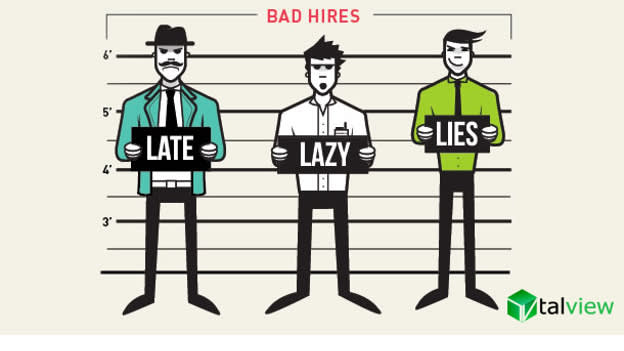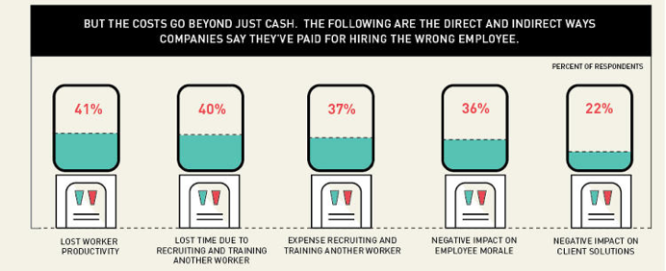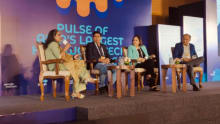Unseen Cost of a Bad Hire

Hiring process is more organized and elaborate now than ever before; and steps involved in hiring have considerably increased. After years of experience on working with bad hires, companies are now realising the monetary and nonmonetary cost of a ‘mis-hire’ or more bluntly put ‘Bad-hire’. Companies have come up with innovative ways to judge the candidates before hiring through hackathons, internships and other internal vetting procedures which will help better understand candidate’s durability, competency and cultural fit in the company. Despite precautions taken by the HR department before hiring candidates, some discrepancy in the hiring process costs dearly to the company.
Some indirect benefits of having good employees are they will be your brand ambassadors, create a culture of comradeship for your business and attract good / similar talent from the industry. Whereas a bad hire could drive away key customers, impair customer loyalty, erode employee morale and trust and drive away high performing employees.
If we look at it statistically, the immediate monetary loss due to a bad hire alone sums up to 30 percent of the employee’s annual income. The negativity that a bad hire leaves behind can be quite lethal for the team and could take considerable amount of time to rejuvenate.

http://www.fastcompany.com/3028628/work-smart/infographic-how-much-a-bad-hire-will-actually-cost-you
Steve Jobs on bad hiring
“
|
I noticed that the dynamic range between what an average person could accomplish and what the best person could accomplish was 50 or 100 to 1. Given that, you're well advised to go after the cream of the cream...A small team of A+ players can run circles around a giant team of B and C players. |
With years of experience in hiring, the HR executives can identify if an employee will stick with the company or not. They gauge the persona of the candidate over initial screening process. It is in the intermediate process where the hiring goes wrong.
Market needs sometimes puts hiring managers in a fix to speeden up the hiring process. This leads to clouding in the main agenda behind hiring, here are five factors that a hiring manager could consider before recruiting:
1. Do you really need to hire someone for this position
There are ample freelancers and independent contractors who are willing to work from home at a much cheaper cost. This will save on several costs including, payroll taxes and benefits, health insurance and paid vacations. Moreover, you could increase the productivity of existing employees.
2 . Check internally for project completion
On several occasions you are over hiring - there usually is a project close to completion and employees are on bench. You could internally hire someone; you save on the interview process, new hire paperwork and the vetting process. This will also save on time-to-hire, a fresh candidate will have to go through an interview process, a notice period to serve - meanwhile the internal employee could be yours.
3. Ask for referrals
Referral hiring programs are quite common in most workplaces - but the involvement may be as low as 20% for average companies and up to 60% for the best of breed. Employees are likely to suggest their competent associates for the job who will stick around in the company. Most workplaces integrate a referral bonus; when the new candidate completes three months of work, the employee gets a bonus. To avail this bonus, employees make sure they refer good candidates.
4. Save time by modernizing your hiring methods
There are umpteen number of modernizing your hiring method - hiring over social media, video interviews, online assessments, selection based on computer algorithms and so on. Once you select the resumes you’re interested in, consider setting up an online video interview with the applicant to get a better sense of who they are. You could set up the assessment and review it at ease. In just a few minutes, you can get a decent read on a person. Be a judge of what sort of attitude you are looking for in the candidate.
5. Develop your own analytics to gauge top performers
Shadow your new hire - see how s/he works, how long does it take for them to finish a given task, and punctuality. Pay close attention to the first few months in work, the longer you take to find out that the new hire is indeed a bad hire will cost you that much more.
We all know that hiring is not a black and white task, it is imperative that right amount of time is spent on deciding whom to hire and if you actually need to hire. A ‘mis-hire’ will not only pile up cost factors for the company, it can be taxing on you as a hiring manager also. Hand-holding new hires can be tedious and time-consuming and the bitterness left behind by the bad hire can also leave you behind in your plans.
From an HR teams perspective you can strengthen the process based on the pervious experiences and also share this article with hiring managers to open up discussions on the impact of bad hire. From an Hiring managers side, although hiring takes time never hire in desperation, a bad candidate will put you further behind schedule than you realize.











